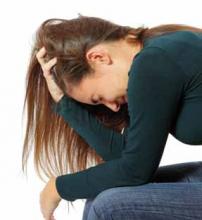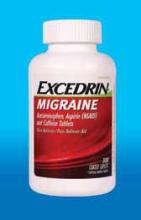Psychiatric comorbidities magnify migraineurs’ medical interventions
BY MICHELE G. SULLIVAN
AT THE AAN 2014 ANNUAL MEETING
PHILADELPHIA—Patients who have migraines and comorbid psychiatric disorders visited the ED more, and received more brain imaging and narcotics, than patients who had only migraine.
The additional emergency visits and procedures—combined with significantly higher rates of hospital admissions and outpatient visits—run contrary to published recommendations, Dr Mia Minen reported at the annual meeting of the American Academy of Neurology (AAN).
The imaging findings of her cross-sectional analysis are particularly troubling in light of current guidelines aimed at helping to minimize radiation exposure by avoiding head and brain imaging in patients with primary headache disorders, said Dr Minen, a fellow at the Graham Headache Center, Boston.“One of the AAN’s recommendations for the Choosing Wisely campaign was not to perform brain imaging for patients presenting to the ED with recurrence of their baseline primary headache disorder,” she said. She added that the American College of Emergency Physicians (ACEP) has not found level A evidence supporting imaging in patients who present to the ED with headache, unless the headache is sudden and severe, or unless it’s accompanied by an abnormal neurological examination.
Her analysis looked at emergency treatment trends in a database of almost 3,000 headache patients seen over a 10-year period in a single hospital’s ED. The patients were a mean of 40 years old; most (80%) were women. About 2,000 had at least one psychiatric comorbidity; the most common psychiatric comorbidities were anxiety and depression.
Over the 10-year study period, migraine patients overall made an average of 11 ED visits, with 10 admissions and 26 outpatient visits. Those patients without a comorbid psychiatric diagnosis made significantly fewer visits in every category: 6 ED visits, 3 inpatient visits, and 11 outpatient visits.
Migraine patients with comorbidities presented a very different picture, Dr Minen said. These patients had an average of 18 ED visits, 19 inpatient visits, and 45 outpatient visits over the study period.
Compared with migraineurs without psychiatric disorders, those with them were significantly more likely to undergo a computed tomography of the head (relative risk, 1.4) and a magnetic resonance image of the brain (RR, 1.5). They received narcotic treatment in the ED significantly more often as well.
“We need more studies to understand why this is the case,” Dr Minen said.
She added that the pharmacotherapy findings also were in contrast to recommendations in the AAN Choosing Wisely campaign.
“In 2013, one of the final recommendations was not to use opiates or butalbital for the treatment of migraine, except in rare circumstances.”
Dr Minen had no financial disclosures.
Dr Lappin is an assistant professor and an attending physician, department of emergency medicine, New York-Presbyterian Hospital/Weill Cornell Medical College, New York.
Study: Excedrin “good choice” as first-line therapy for migraine in ED
BY BRUCE JANCIN
AT SAEM 2014
DALLAS—Acetaminophen, aspirin, and caffeine in combination—the tablet familiarly known as Excedrin—proved an attractive alternative to intravenous prochlorperazine as first-line therapy for uncomplicated acute migraine in the emergency department, in a randomized, prospective, double-blind clinical trial.
“Excedrin worked as well as prochlorperazine in this study and doesn’t require an IV. I think it’s a good choice for acute cephalgia without significant nausea and vomiting,” Dr Kenneth R. Deitch said at the annual meeting of the Society for Academic Emergency Medicine.In this 71-patient study, both therapies provided significant and comparable pain relief at 60 minutes. Restlessness and/or muscle spasms occurred within the first 120 minutes in 10 patients in the prochlorperazine group and in 3 on acetaminophen, aspirin, and caffeine (AAC). At follow-up 24 hours later, roughly 90% of patients in each study arm said they would use their study medication again, according to Dr Deitch, an emergency medicine physician at Einstein Medical Center, Philadelphia.
All study participants met International Headache Society criteria for migraine or probable migraine. They were randomized to receive 10 mg of prochlorperazine IV in a 2-minute push plus placebo, or two generic AAC tablets, each containing 250 mg of acetaminophen, 250 mg of aspirin, and 65 mg of caffeine, along with a placebo IV.
The primary endpoint was reduction in pain on a 0-100 visual analog scale at 60 minutes post treatment. The mean reduction was 47 points in the prochlorperazine group and 37 points with AAC; the difference was not statistically significant.
If patients reported inadequate pain relief after 60 minutes, the study code was broken and physicians prescribed a rescue medication of their choosing—most often an opiate. Ten patients in each study arm required the use of rescue medication after 60 minutes.


